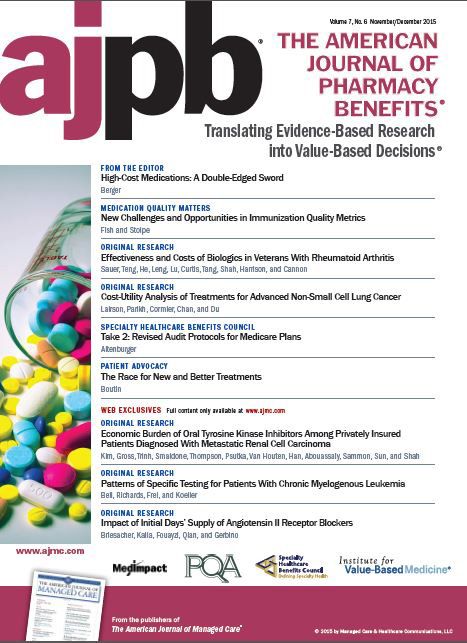Publication
Article
AJPB® Translating Evidence-Based Research Into Value-Based Decisions®
High-Cost Medications: A Double-Edged Sword
Author(s):
Although the focus in drug trends has primarily been on unit cost, it is time we look at the other factors involved, including value and quality of life.
The last few months have brought a great deal of attention to the skyrocketing costs associated with prescription medications, both small molecule and biotech. Not a day goes by without articles in the popular press on this topic, and it has even become a major topic in the 2016 presidential campaign. Over the last 10 years, the pharmacy benefit management organizations have trained us to look at 3 key factors that are associated with drug trend: unit cost, utilization of medications, and drug mix. Most of our angst and activity has been focused on the unit cost issue, but it is time we look at the other factors involved, including value and quality of life.
Karen was born in 1959 with cystic fibrosis (CF). The bad news for Karen was that the disease was fatal and the average child would survive only 3 years at that time. The good news was that her parents were in a position to give her all the medical support available at that time, although there was little; her family spent only a few thousand dollars on the medications to address Karen’s condition. Fast forward to 2015 and a child born with CF could still have a terrible disease, but the average life expectancy is almost 50 years old. Why the significant change in course and outcome of the disease?
There are a number of reasons. Treatment modalities have changed over the last 50 years; one very important area is in the medications available to treat the condition, symptoms, and complications. Recently, new medications have become available to individuals with CF, and while they have great potential, there is also a downside. The issue: they cost approximately $300,000 for 1 year of treatment.
In 1999, when I began working in the pharmacy benefit management environment, there was little talk of specialty medications. There were a few that existed, but for the most part, that era focused on small molecule medications. Early in the 2000s, we began to broaden our focus; we went to our clients and shared information with them on an increasing trend in new biotech medications. Biotech drugs were rarely found in a client’s top 20 most-utilized medications, but fast forward to 2015, and there is now significant use of these medications. In 2016, 7 of the top 10 client medications will be these large molecule medications.
The increasing availability and use of these medications has created an enormous amount of hand-wringing due to the associated costs. Yes, they are expensive, but I would argue that we are forgetting the potential life-changing effect some of these medications can have. I am not here to argue about what the cost should be (I will leave that for another column), but I would say that we need to look at the value. In the case of CF, today’s patients are living significantly longer lives with a quality of life that differs greatly from individuals like Karen. They are able to grow to be productive members of the workforce and contribute in ways that were never thought to be possible before.
Yes, cost is a very real issue—one that has to be addressed—and I do not deny that. I just think we need to take a moment and give credit to many of these medications that have changed the quality of millions of lives for the better.







